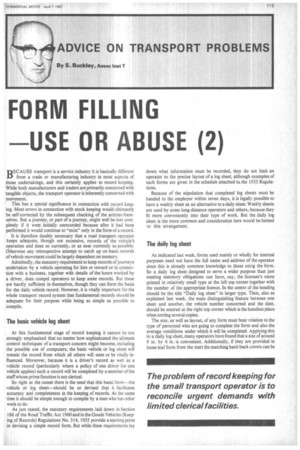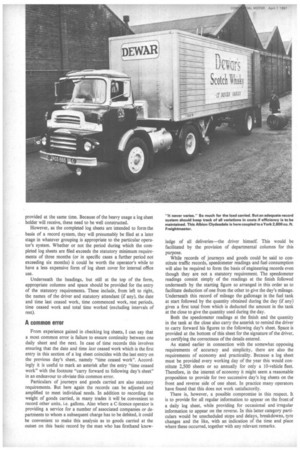FORM FILLING USE OR ABUSE (2)
Page 117

Page 118

If you've noticed an error in this article please click here to report it so we can fix it.
BECAUSE transport is a service industry it is basically different from a trade or manufacturing industry in most aspects of those undertakings, and this certainly applies to record keeping. While both manufacturers and traders are primarily concerned with tangible objects, the transport operator is inherently concerned with movement.
This has a special significance in connection with record keeping. Most errors in connection with stack keeping would ultimately be self-corrected by the subsequent checking of the articles themselves. But a journey, or part of a journey, might well be lost completely if it went initially unrecorded because after it had been performed it would continue to "exist" only in the form of a record.
It is therefore doubly necessary that a road transport operator keeps adequate, though not excessive, records of the vehicle's operation and does so currently, or as near currently as possible. Otherwise any retrospective attempt to catch up on basic records of vehicle movement could be largely dependent on memory.
Admittedly, the statutory requirement to keep records of journeys undertaken by a vehicle operating for hire or reward or in connecfion with a business, together with details of the hours worked by a driver, does compel operators to keep some records. But these are hardly sufficient in themselves, though they can form the basis for the daily vehicle record. However, it is vitally important for the whole transport record system that fundamental records should be adequate for their purpose while being as simple as possible to compile.
The basic vehicle log sheet
At this fundamental stage of record keeping it cannot be too strongly emphasized that no matter how sophisticated the ultimate control techniques of a transport concern might become, including the possible use of computers, the basic vehicle or log sheet will remain the record from which all others will stem or be vitally influenced. Moreover, because it is a driver's record as well as a vehicle record (particularly where a policy of one driver for one vehicle applies) such a record will be completed by a member of the staff whose prime function is not clerical.
So right at the outset there is the need that this basic form—the vehicle or log sheet—should be so devised that it facilitates accuracy and completeness in the keeping of records. At the same time it should be simple enough to compile by a man who has other work to do.
As just stated, the statutory requirements laid down in Section 186 of the Road Traffic Act 1960 and in the Goods Vehicles (Keeping of Records) Regulations No. 314, 1935 provide a starting point in devising a simple record form. But while these requirements lay down what information must be recorded, they do not limit an operator to the precise layout of a log sheet, although examples of such forms are given in the schedule attached to_ the 1935 Regulations.
Because of the stipulation that completed log sheets must be handed to the employer within seven days, it is legally possible to have a weekly sheet as an alternative to a daily sheet. Weekly sheets are used by some long-distance operators and others, because they fit more conveniently into their type of work. But the daily log sheet is the more common and consideration here would be limited to this arrangement.
The daily log sheet
As indicated last week, forms used mainly or wholly for internal purposes need not have the full name and address of the operator since this is already common knowledge to those using the form. So a daily log sheet designed to serve a wider purpose than just meeting statutory obligations can have, say, the licensee's name printed in relatively small type at the left top corner together with the number of the appropriate licence. In the centre of the heading should be the title "Daily log sheet" in larger type. Then, also as explained last week, the main distinguishing feature between one sheet and another, the vehicle number concerned and the date, should be entered at the right top corner which is the handiest place when sorting several copies.
The size, as well as layout, of any form must bear relation to the type of personnel who are going to complete the form and also the average conditions under which it will be completed. Applying this to a daily log sheet, many operators have found that a size of around 9 in. by 6 in. is convenient. Additionally, if they are provided in loose-leaf form from the start the matching hard-back covers can be provided at the same time. Because of the heavy usage a log sheet holder will receive, these need to be well constructed.
However, as the completed log sheets are intended to form the basis of a record system, they will presumably be filed at a later stage in whatever grouping is appropriate to the particular operator's system. Whether or not the period during which the completed log sheets are filed exceeds the statutory minimum requirements of three months (or in specific cases a further period not exceeding six months) it could be worth the operator's while to have a less expensive form of log sheet cover for internal office use.
Underneath the headings, but still at the top of the form, appropriate columns and space should be provided for the entry of the statutory requirements. These include, from left to right, the names of the driver and statutory attendant (if any), the date and time last ceased work, time commenced work, rest periods, time ceased work and total time worked (excluding intervals of rest).
A common error
From experience gained in checking log sheets, I can say that a most common error is failure to ensure continuity between one daily sheet and the next. In case of time records this involves ensuring that the date and time last ceased work which is the first entry in this section of a log sheet coincides with the last entry on the previous day's sheet, namely "time ceased work". Accordingly it is useful to mark an asterisk after the entry "time ceased work" with the footnote "carry forward to following day's sheet" in an endeavour to obviate this common error.
Particulars of journeys and goods carried are also statutory requirements. But here again the records can be adjusted and amplified to meet individual needs. In addition to recording the weight of goods carried, in many trades it will be convenient to record other units, i.e. gallons. Also where a C-licence operator is providing a service for a number of associated companies or departments to whom a subsequent charge has to be debited, it could be convenient to make this analysis as to goods carried at the outset on this basic record by the man who has firsthand know ledge of all deliveries—the driver himself. This would be facilitated by the provision of departmental columns for this purpose.
While records of journeys and goods could be said to constitute traffic records, speedometer readings and fuel consumption will also be required to form the basis of engineering records even though they are not a statutory requirement. The speedometer readings consist simply of the readings at the finish followed underneath by the starting figure so arranged in this order as to facilitate deduction of one from the other to give the day's mileage. Underneath this record of mileage the gallonage in the fuel tank at start followed by the quantity obtained during the day (if any) gives a first total from which is deducted the amount in the tank at the close to give the quantity used during the day.
Both the speedometer readings at the finish and the quantity in the tank at the close also carry the asterisk to remind the driver to carry forward his figures to the following day's sheet. Space is provided at the bottom of this sheet for the signature of the driver, so certifying the correctness of the details entered.
As stated earlier in connection with the somewhat opposing requirements of accuracy and simplicity, there are also the requirements of economy and practicality. Because a log sheet must be provided every working day of the year this would constitute 2,500 sheets or so annually for only a 10-vehicle fleet. Therefore, in the interest of economy it might seem a reasonable proposition to provide for two successive day's log sheets on the front and reverse side of one sheet. In practice many operators have found that this does not work satisfactorily.
There is, however, a possible compromise in this respect. It is to provide for all regular information to appear on the front of a daily log sheet, while providing for occasional and irregular information to appear on the reverse. In this latter category particulars would be unscheduled stops and delays, breakdowns, tyre changes and the like, with an indication of the time and place where these occurred, together with any relevant remarks.
































































































































































